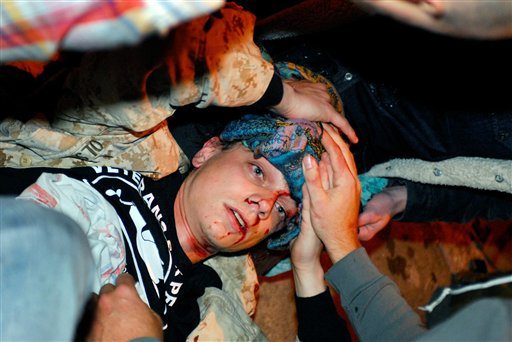PORTLAND, Ore. (AP) — If an Iraq War veteran’s injury during a California protest comes to stand as a symbol of the Occupy Wall Street movement, protesters in Portland also hope it draws attention to what they say is the city’s problem with police violence.
Scott Olsen, whose skull was fractured when police moved in on an Oakland encampment, has become a symbol for protesters in Portland, where the police bureau has recently been accused of excessive force in dealings with the city’s black and mentally ill populations.
“It’s a focal point for people,” protest organizer Andrea Townsend said. “We are tired of having these interactions with police in our communities.”
At a rally and march of about 300 people in an open-air amphitheater next to the Occupy Portland camp, Iraq War veteran Micaiah Dutt told the crowd that the Olsen incident brought the issue of police violence to the attention of many veterans.
“Scott Olsen stood for truth, and he was brutalized by police in Oakland,” Dutt said. “It took that incident to wake (veterans) up to it.”
Dutt said blacks, Hispanics and labor groups are well-versed in police violence. “The vets are not going to stand for it,” he said.
About 150 protesters broke off from the main group and crossed a bridge to the city’s east side, despite an announcement from police that those who took the bridge faced arrest.
A few tense moments ensued. Protesters watched and waited as police cruisers and motorcycles with lights flashing approached but the march continued. It ended two hours later at the Occupy Portland camp in the city’s downtown.
Police said one man who shoved a police sergeant into a moving bus during the march, then ran back into the crowd, was located and arrested after the march was over. The officer suffered minor injuries, Lt. Robert King said.
Marchers were also demonstrating against Ronald Frashour, a police officer who shot and killed an unarmed black man suffering from mental health issues in January 2010. Frashour has since left the force and is fighting to get his job back.
The mentally ill and Portland police have had a series of run-ins that led to injuries and deaths. The most prominent case involved the death of James Chasse Jr., who had schizophrenia and was chased and tackled by officers after he allegedly urinated in public.
Chasse suffered broken ribs that punctured his lung and led to his death in September 2006. He also was shot with a stun gun.
The shootings in Portland led to a probe by the U.S. Department of Justice, which found cause for a full investigation after a preliminary look at the use of force by Portland Police Bureau officers. The investigation, launched in June and still ongoing, is trying to determine whether there is any pattern of civil rights violations by Portland police.
Military veterans at Occupy Portland on Wednesday said they’re glad Olsen’s plight has brought attention to the veterans supporting the Occupy Wall Street movement but expressed mixed emotions about using Olsen as a symbol.
Justin Dorwin, a five-year veteran of the Marines, said Olsen’s injury prompted him to join the protest but said he disagrees with the distribution of a flier that features an image of a bloodied Olsen lying on his back.
“His eyes are glazed over, people’s hands are trying to stop the bleeding on his head,” Dorwin said. “It’s absolutely way too gruesome. I think it’s propaganda trying to incite emotion. It angers me to my bones that somebody would use Lance Cpl. Olsen as a rally point.”
Other Oregon protests inspired by the Occupy Wall Street movement were moving or closing this week. In Eugene, protesters moved to a new encampment to clear the way for a Saturday market and continue to search for a permanent camp. In Ashland, protesters left Friday, 22 days after they occupied the town plaza. The camp drew about 250 people.
U.S. Army veteran Eddie Ebacher, who served from 1976 to 1981, compared Olsen to Crispus Attucks, the first person shot to death during the Boston Massacre in 1770.
“The last time we had this kind of sentiment in this country, it was the Boston Tea Party,” Ebacher said. “I’m sorry (Olsen) had to be injured that way, but I guess he’s a martyr for our cause.”
Nigel Duara can be reached at http://www.twitter.com/nigelduara.



